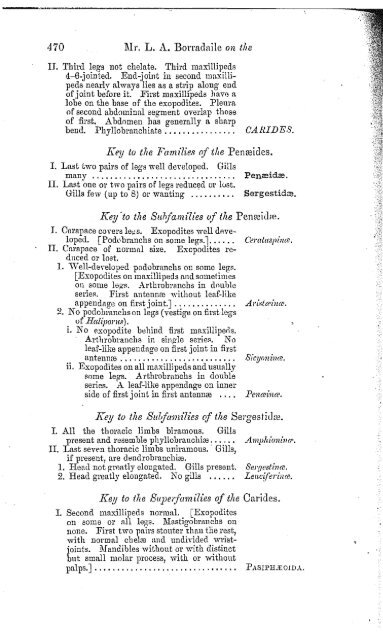On the Classification of the Decapod Crustaceans. By L. A. ...
On the Classification of the Decapod Crustaceans. By L. A. ...
On the Classification of the Decapod Crustaceans. By L. A. ...
Create successful ePaper yourself
Turn your PDF publications into a flip-book with our unique Google optimized e-Paper software.
470 Mr. L. A. Borradaile on <strong>the</strong><br />
II. Third legs not chelate. Third niaxillipeds<br />
4-6-jointed. End-joint in second maxillipeds<br />
nearly always lies as a strip along- end<br />
<strong>of</strong> joint before it. First maxillipeds have a<br />
lobe on <strong>the</strong> base <strong>of</strong> <strong>the</strong> exopodites. Pleura<br />
<strong>of</strong> second abdominal segment overlap those<br />
<strong>of</strong> first. Abdomen has generally a sharp<br />
bend. Phyllobranchiate CA RIDES.<br />
Key to <strong>the</strong> Families <strong>of</strong> <strong>the</strong> PenEeides.<br />
I. Last two pairs <strong>of</strong> legs well developed. Gills<br />
many<br />
II. Last one or two pairs <strong>of</strong> legs reduced or lost.<br />
Gills few (up to 8) or wanting<br />
Penaeids.<br />
Sergestidse.<br />
Key to <strong>the</strong> Suhfamilies <strong>of</strong> <strong>the</strong> Penreid;e.<br />
I. Carapace covers le^s. Exopodites well developed.<br />
[Podobranchs on some legs.") Cerataspince.<br />
II. Carapace <strong>of</strong> normal size. Exopodites reduced<br />
or lost.<br />
1. Well-developed podobranchs on some legs.<br />
[Exopodites on maxillipeds and sometimes<br />
on some leg's. Arthrobranchs in double<br />
series. First antennae without leaf-like<br />
appendage on first joint]<br />
Arktceinw.<br />
2. No podobranchs on legs (vestige on first legs<br />
<strong>of</strong> Haliporus).<br />
i. No exopodite behind first maxilliperls.<br />
Arthrobranchs in single series. No<br />
leaf-like appendage on first joint in first<br />
antennre<br />
Sicyoniiice.<br />
ii. Exopodites on all maxillipeds and usually<br />
some legs. Arthrobranchs in double<br />
series. A leaf-like appendage on inner<br />
side <strong>of</strong> first joint in first antennae .... Penceina?.<br />
Key to <strong>the</strong> Subfamilies <strong>of</strong> <strong>the</strong> Sergestidaa.<br />
I. All <strong>the</strong> thoracic limbs biramous. Gills<br />
present and resemble phyllobranchife Amphionincf.<br />
II. Last seven thoracic limbs uniramous. Gills,<br />
if present, are dendrobranehise.<br />
1. Head not greatly elongated. Gills present. Serpestinai.<br />
2. Head greatly elongated. No gills Leuciferince.<br />
Key to <strong>the</strong> Superfamilies <strong>of</strong> <strong>the</strong> Carides.<br />
I. Second maxillipeds normal. [Exopodites<br />
on some or all legs. Mastigobranchs on<br />
none. First two pairs stouter than <strong>the</strong> rest,<br />
with normal chelae and undivided wristjoints.<br />
Mandibles without or with distinct<br />
but small molar process, with or without<br />
palps.]<br />
PASIPHJEOIDA.
















